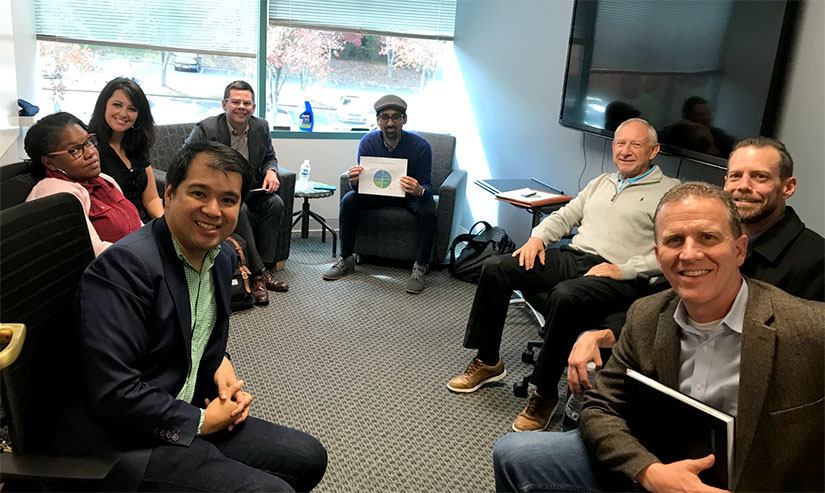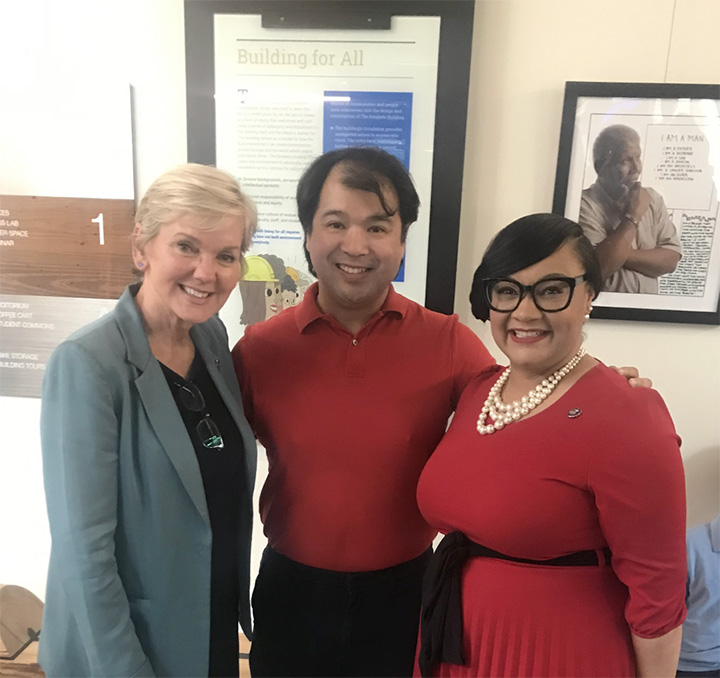Boosting Building Efficiency in Unincorporated Norcross, Georgia

CEO of Lucky Shoals Community Association and Georgia State Representative Marvin Lim (front left) meets with Team Georgia HD 98. Members include representatives from the Georgia Hispanic Construction Association, the Gwinnett Housing Corporation, and the Southeast Energy Efficiency Alliance. Photo from Marvin Lim
The 17,642 households who live in unincorporated Norcross, Georgia, are surrounded by more than 10 million square feet of aging commercial buildings zoned for industrial and business activities. Residents face poor air quality and chronic health conditions because of airborne diesel particulate matter and proximity to facilities that use hazardous substances.
Lucky Shoals Community Association Executive Director Marvin Lim, whose organization represents residents of more than 10 diverse neighborhoods in unincorporated Norcross, wanted to tackle this blend of residential and commercial challenges, but he did not know where to start. So he applied to the U.S. Department of Energy's Clean Energy to Communities (C2C) Expert Match program, where he connected with National Renewable Energy Laboratory (NREL) researchers skilled in energy problem solving through a community lens.
C2C Expert Match is a dialogue-driven collaboration for communities—and energy expertise is not a prerequisite to benefit from the program, which pairs communities with energy researchers at national laboratories to address short-term energy challenges and goals.

Energy Secretary Jennifer M. Granholm, Georgia State Representative Marvin Lim, and Congresswoman Nikema Williams (left to right).
"What really attracted me to C2C Expert Match was its low barrier to entry," said Lim, who also serves as a Georgia State Representative for House District 98. "We knew what our needs were, but we weren't project-ready, and we lacked technical expertise, so Expert Match was a really great way to help us bridge that gap."
NREL partnered with the Atlanta-based nonprofit Southeast Energy Efficiency Alliance (SEEA) to identify the appropriate project objectives to meet community needs, which included developing talking points for engaging with energy stakeholders.
The Expert Match team of SEEA and NREL experts focused on finding opportunities for building efficiency improvements that could improve affordability for business owners and tenants while reducing the greenhouse gas emissions associated with building operations.
"Their goal was to understand how they could modernize their commercial building stock and whether that could eventually lead to future energy initiatives for the region like electric vehicle charging or commercial solar projects," said Alexandra Kramer, NREL researcher and project coordinator for unincorporated Norcross.
Twenty percent of the households in unincorporated Norcross are at or below the poverty level, and more than 85% of households are Black, Indigenous, or people of color. Historic exclusionary policies and practices, such as redlining and zoning laws, have purposefully placed low-income communities and communities of color closer to these environmental hazards and thus further from economic opportunities available to other communities.
Shanti Pless, a building energy efficiency researcher at NREL, has spent 23 years focused on net-zero buildings, electrification, and decarbonization of commercial building stock. So he was prepared when he learned unincorporated Norcross had more than 400 commercial buildings to analyze.
"I partner a lot with developers, building owners, and city leaders on projects trying to achieve net zero through retrofit projects or through new construction," Pless said. "I think a lot about design process and emerging technology approaches to do things more cost-effectively and affordably."
With so many buildings to consider, unincorporated Norcross needed help figuring out which buildings to prioritize and what the biggest opportunities for improvement were.
That level of analysis required reliable and robust data. NREL built a data set representing all 400 commercial buildings, including their vintage, size, ownership type, and construction activities. This data set was then processed with NREL's ComStock™ tool, which analyzed how the buildings used their energy, such as how much gas or electricity a building used and for which end uses. ComStock helped the team identify which demand-side management strategies could improve energy use patterns.
For example, the analysis showed that only a few upgrades had been made to commercial building rooftop heating, ventilation, and air-conditioning (HVAC) units and few retail establishments had engaged in reroofing. Even though there are acres of flat roofs available for solar, only one solar permit had been pulled for unincorporated Norcross since 2010. Adopting more efficient HVAC equipment and rooftop solar power were untapped opportunities this project discovered.
"Learning what solar can do for commercial buildings—that wasn't even my thought when I entered this program," Lim said. "But finding out that so few businesses have even explored the opportunity, I think it's not because there's a lack of interest. There needs to be a push to lower that barrier to access."
The final report included an analysis of commercial building data, fuel station analysis, two case studies of similar successful efforts, financial incentives that unincorporated Norcross could qualify for, and next steps for identified opportunities.
"Having evidence-based information is going to be really valuable to promote planning for building modernization and future infrastructure developments," Kramer said.
The report structure was heavily influenced by Lucky Shoals' need for talking points to engage with stakeholders.
"I think the group—myself, NREL, and SEEA—came up with this idea of structuring the report in a way where it can have an impact when the community is out there trying to pitch projects," Lim said.
Unincorporated Norcross Builds Momentum With Partnerships
Inspired by findings from the analysis, Lim applied for and was accepted to the Solar Energy Innovation Network's (SEIN's) technical assistance program, Assistance for Early Adopters, to pursue solar solutions replicating findings from SEIN projects. The unincorporated Norcross project with SEIN's Assistance for Early Adopters used data compiled from the ComStock analysis to model the optimized size and cost of rooftop solar PV installations for various commercial building types using NREL's REopt Tool. And to facilitate future success, the Expert Match team connected Lucky Shoals with the unincorporated Norcross utility, Georgia Power.
"Our role includes building relationships and facilitating between the community and their utility," Kramer said. "It's important to be able to work with the utility to align rebates, resources, and incentives that community members can take advantage of."
Lim has used the C2C Expert Match report findings in discussions with the Georgia Hispanic Construction Association and the Community Improvement District—a special tax jurisdiction for commercial areas.
"We've been able to tell them, 'Here are the opportunities and how you can position yourself to benefit,'" Lim said. "We've been able to use this data to put the conversation forward."
Lim hopes the changes to come will help business owners and residents alike.
"We all have to live together," Lim said, "and my hope is by using the information we can find ways with all of our properties, residential and commercial, to impact not only on the business owners and their utility costs but all of the residents, many of whom live next to these commercial properties."
Reflecting on how much he was able to accomplish over a few months with C2C Expert Match, Lim encouraged other communities to apply for both Expert Match and the Solar Energy Innovation Network.
"Coming from an under-resourced community, we don't have a lot of access to experts or people in a field such as clean energy that can address disparities in communities like mine," he said.
C2C Expert Match is designed to meet communities where they are in their learning and planning process.
"The dialogue was on a very everyday-person level," Lim said. "It was clear that they were very interested in the perspectives of the community and really taking the lead of the community."
C2C connects community-based groups, local governments, utilities, and other organizations with national laboratory experts to close the gaps between communities' clean energy ambitions and real-world deployment. The technical assistance offered through C2C can offer meaningful insights around clean energy decision-making to help communities achieve resilient clean energy systems that embody local and regional priorities. For example, C2C analysis can provide insights on the financial and social costs and benefits of electric vehicles, geothermal systems, or capturing and storing solar energy. Such analysis provides community-specific information on the funding and support needed to bring clean energy projects to fruition.
Expert Match is one offering of the C2C program that provides 40–60 hours of technical assistance to communities over the course of 2–3 months and reviews applications on a rolling basis. Learn more about the C2C Expert Match program and find out how to apply.
Last Updated May 28, 2025
